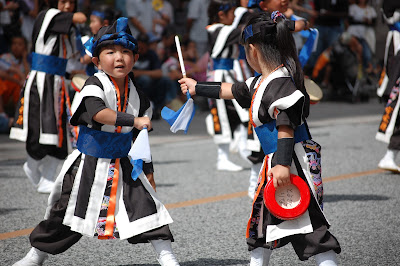Meet Kuruma, my new-to-me Japanese car.
While I spent many hours at the dealerships looking at cute pink cars, I settled on this car when I saw it listed in the classifieds at a price I could not resist. The previous owner is a fighter pilot with the Air Force and was leaving the island. I am still amused by the thought of a person who is accustomed to Mach speed cruising around the island in this cute little car.
Kuruma (Japanese for car) is a 1998 Nissan March. Not sold in the states, the March has been around parts of Asia since the 1980s. It's funny how similar it is to my very first car, which was also a Nissan. The major difference, of course, is that the steering wheel is on the other side of the car.

I've adjusted quite well to driving on the left side of the road. It only took a day or two to feel normal on the "wrong" side of the road. The roads here can be very narrow and challenging to navigate, and it seems perfectly acceptable to stop in the middle of the road if you want to jump out and grab something from a vending machine or whatnot. I suppose this is one of the reasons the speed limit is so low here. In residential areas and narrower streets, the speed limit is as low as 40 kph (about 25 mph). On the major, multi-laned prefectural routes, you can go a "fast" 60 kph (nearly 40 mph). This now, sadly, feels lightening fast to me. I also found it amusing that we Americans were specifically told in our newcomer's orientation that "drifting," made popular by the movie The Fast and the Furious, is strictly prohibited. Guess I have to go to Tokyo for that.
I took a couple pictures of the roads with my iPhone on my way home today. Not the best quality, but gives you a glimpse of what the roads are like here. No cars or animals were hit in the process.
A couple of fellow "Y-plates"
A major prefectural route. Kadena Air Force Base to the right.
Bridge across the "green river" (it looks green from the surrounding trees reflecting off it it)

Yes, there is a Starbucks in my neighborhood. Note the ceramic dragon/dogs at the entrance (Shisa) - future post to come about these guys.
I was warned that the roads in Okinawa get very slippery when it rains out. This is because the Japanese use a coral mixture in the road pavement. While it may be cost effective to use coral, it does make for a slicker surface in the rain. For this reason, you'll occassionally see red sections of pavement, usually on curves or slopes. These sections prevent slipping where it's most needed.
This section is a declined slope on the road.
While driving through neighborhoods, you'll encounter many blind intersections where you can't see to your left or right to check for traffic. In this situation, you rely on the mirrors posted at the intersection.
Two mirrors on the left corner on the intersection in my neighborhood. Ocean is straight ahead.
I've observed a few things about cars and Japanese drivers. First of all, a Japanese car doesn't seem complete without some sort of decorations inside. The more you have, the cooler you look. Stuffed animals seem to be popular. They are displayed proudly on dashboards and rear windows. And I rarely see a Japanese car without a tissue box displayed prominently. Other options include curtains for your car windows. Why not? They can add a splash of color and keep the sun off of you. I'm wondering if these have ever been blamed for a car accident before. "Sorry man, I didn't see you with my curtains closed...I'm sure you understand. Hey, nice tissue box!" I don't have curtains or a tissue box yet, but I do have a small stuffed animal I got when I bought my cell phone. I have a lot of catching up to do if I want to fit in!





















































